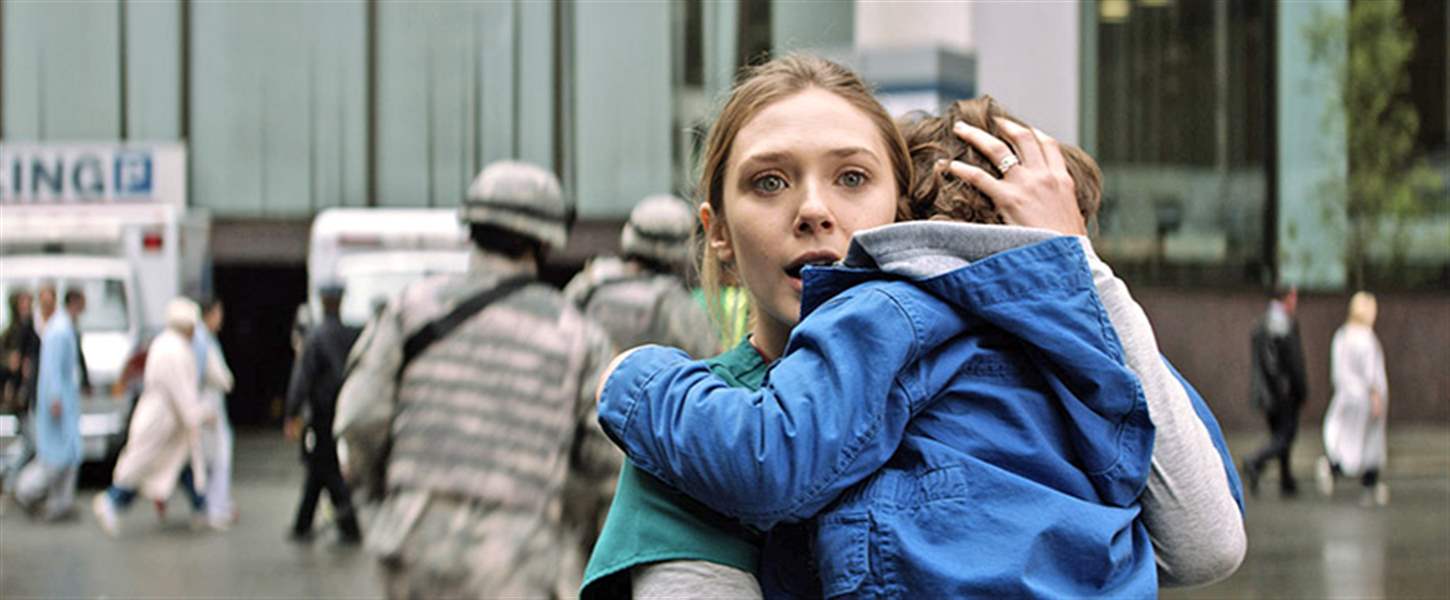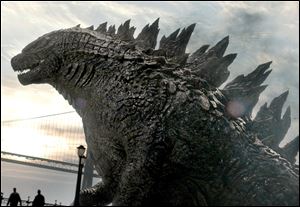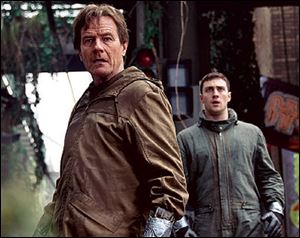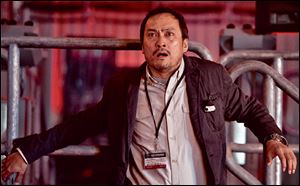
PEACH WEEKENDER
New ‘Godzilla’ rescues 60-year-old franchise
5/15/2014
Elizabeth Olsen in s a scene from the film.
WARNER BROS.

A scene from the new 'Godzilla' flm.

Bryan Cranston, left, and Aaron Taylor- Johnson
Standing 350 feet tall, the 2014 Godzilla is bigger than any of its previous incarnations.
Even more impressive, however, is its new film.
Dark, grim, and surprisingly human, the Godzilla reboot is the most substantive film in the long-running kaiju series since the 1954 original from Ishirô Honda and its themes of nuclear holocaust. It’s arguably the franchise’s most important sequel as well, considering the negative impact of the 1998 Godzilla, a Hollywood-made atrocity that nearly did what massive human armies and mega-beasts couldn’t: kill the King of Monsters.
★★★★
Directed by Gareth Edwards.
Written by Max Borenstein and Dave Callaham, based the Toho Studios Godzilla movies.
A Warner Bros. release.
Playing at Franklin Park, Fallen Timbers, and Levis Commons.
Rated PG-13 for intense sequences of destruction, mayhem, and creature violence.
Running time: 123 minutes.
Cast: Aaron Taylor- Johnson, Ken Watanabe, Elizabeth Olsen, Sally Hawkins, Bryan Cranston, Juliette Binoche, David Strathairn.
As an in-joke, the new film even opens in 1999, a year after the Roland Emmerich failure, before jumping to present day. Godzilla 2014’s director Gareth Edwards and screenwriter Max Borenstein — along with a major script assist by Frank Darabont — clearly want a fresh start. Having a cast headlined by Bryan Cranston, and that also features Ken Watanabe, Sally Hawkins, Aaron Taylor-Johnson, Elizabeth Olsen, and Juliette Binoche only helps to differentiate their Godzilla from its past.
Not surprisingly, Cranston plays the film’s most interesting character, Joe Brody, a former nuclear scientist obsessed with a catastrophic Pacific Ocean quake in 1999 that toppled the Japanese nuclear plant where he worked and caused the death of his wife.
Joe’s convinced the seismic activity was too consistent to be random earthquakes. Fifteen years after the accident, his son Ford (Taylor-Johnson), a military demolitions expert with a family of his own, wants little to do with his crackpot father. So he’s not happy about flying to Japan to bail out Dad from jail, much less accompanying him to their abandoned home, now part of a sealed-off radioactive hotspot near the former nuclear plant. Only the area’s neither radioactive nor abandoned.
After being arrested for trespassing, an enraged Joe demands answers from those behind this facade.

Ken Watanabe portrays a scientist in the new film.
He doesn’t have to wait long.
A giant winged creature emerges from its cocoon and destroys the facility before flying away. The beast called MUTO feeds on radiation, and for protection sends out massive EMP waves, frying nearby electric grids and rendering modern technology including jets and navy vessels powerless.
And this is the smaller male; his female mate, which just escaped from captivity in the Yucca Mountain nuclear waste repository in Nevada, is more than double his size — and she’s carrying hundreds of eggs.
Just as it’s not looking good for humanity, Godzilla shows up in one of the more impressive debuts in recent memory, complete with a cranked up-version of the familiar war cry. Described as a “god” by the scientists who have chased and studied it (Watanabe, Hawkins), Godzilla is the alpha-predator of a prehistoric species that fed off abundant radiation on the Earth, before retreating to the deep sea to be closer to the planet’s core. It was nuclear testing in the 1950s that awoke this sleeping beast and which was subsequently unsuccessful in killing it. But now Godzilla is our only hope. As Dr. Ichiro Serizawa (Watanabe) says, “Nature has an order … a power to restore balance.”
But the U.S. military, with the West Coast threatened by a battle for survival between the three creatures, prefers the nuclear option, thinking a much larger blast will wipe out everything.
If nothing else this plan gives Ford something to do, other than fretting about his wife (Olsen) and son, who are trapped in San Francisco, soon to be ground zero for the battle royale. And so he teams up with other military units to chase after the MUTOs, hoping to lure them and Godzilla to a nuclear bomb and then detonate it somewhere in the Pacific Ocean.
Taylor-Johnson is dependably serious and strong, but it’s a role that requires little more than reaction — to his father, his wife, Elle, the monsters, and whatever his circumstance — while Olsen is around just long enough onscreen for us to care about the predicament of Elle and her son.

Elizabeth Olsen in s a scene from the film.
Watanabe’s chief job is to stare incredulously at the monsters and the wanton destruction, while blasting our hubris — “The arrogance of man is thinking nature is in our control and not the other way around” — even though he was instrumental in creating this circumstance. There’s even less for Hawkins to do. And let’s just say Binoche’s role is minor but memorable. But just having their combined talents onscreen — even in small doses — bolsters the human factor of the film.
Knowing the limitations of character development in a Man-in-Suit spectacle, writer-director Guillermo del Toro scaled back the dialogue and emotions to cartoonish levels in last summer’s wonderfully fun Pacific Rim. Godzilla takes itself far more seriously, however, with a creature that’s less good guy than antihero for a post-911, post-tsunami world; one in which collapsing buildings and titanic waves racing through city streets are no longer spectacles of summer movie escapism, but reminders of horrifyingly real events.
The monster isn't overplayed, either. Unlike so many CGI-fests, Godzilla is a minimum participant, popping up in the perfect moments, with a presence that’s always felt, in large part through the personality of Alexandre Desplat’s (The King’s Speech) dark score.
But this is a film about Edwards as much as its title character, as the British filmmaker brings uninhibited enthusiasm and creative daring to a 60-year-old franchise ripe for a new vision. There are moments big and small that resonate with artistry rarely seen in the genre. The sequence where Ford and other soldiers jump out of a military plane, leaving trails of red smoke in the sky behind them, while the eerie "Dawn of Man" piece from 2001: A Space Odyssey plays, is among the single greatest moments of the kaiju genre. Conversely, a moment where a wounded Godzilla looks eye to eye with Ford, resonates with emotion. It's a quiet and stirring scene that all too easily could have been laughably bad.
As a showcase of his filmmaking talents, this summer spectacle puts Edwards in good company with a young Steven Spielberg and George Lucas, who defined the tentpole release in the 1970s, decades before the studios had a name for it. Godzilla brings the giant atomic-breath reptile roaring back to life, and makes its director one to watch in the summer films to come.
Contact Kirk Baird atkbaird@theblade.com or 419-724-6734.